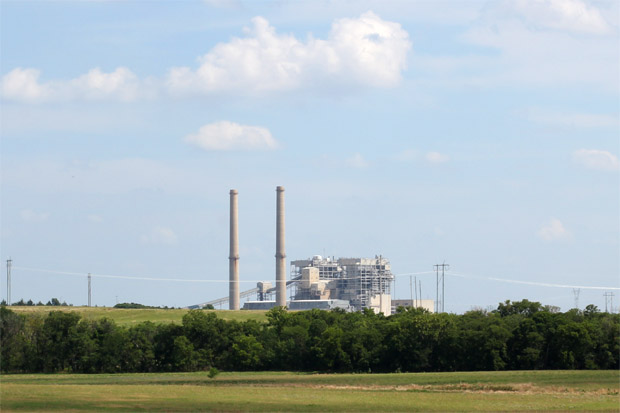Environmentalists: Regional Haze Ruling in Texas Means Cleaner Air in Oklahoma
-
Logan Layden

Joe Wertz / StateImpact Oklahoma
Oklahoma Gas & Electric's coal-fired Sooner Plant near Red Rock, Okla.
On Nov. 24, the U.S. Environmental Protection Agency announced its determination that Texas’ plan to reduce haze-causing emissions from its coal-fired power plants wouldn’t do enough to clear the air at national parks and wildlife refuges, including the Wichita National Wildlife Refuge in southwest Oklahoma.
Instead, the EPA will set the standards, which will likely force some plants to switch to natural gas or install expensive air scrubbers. The Texas Commission on Environmental Quality didn’t take the news well, saying the EPA’s requirements would cost electricity customers billions of dollars for “a negligible increase in visibility.”
Oklahoma Attorney General Scott Pruitt and Oklahoma Gas & Electric — the state’s largest utility — fought the EPA hard when it made a similar determination about Oklahoma’s regional haze plan in 2013, before the U.S. Supreme Court declined to hear Pruitt’s case. Pruitt calls the regional haze rule an example of federal overreach that, as he told StateImpact in an email in May, “places the states in an inferior position to EPA’s command and control approach…”
OG&E has said the cost of upgrading coal plants or switching them to natural gas would be passed on to utility customers, but better air quality and the restoration of unspoiled views of majestic landscapes don’t have to be bought with higher prices for electricity, according to Emily Rosenwasser with the Sierra Club’s Beyond Coal Campaign, because “recent history has shown that Oklahoma regional haze action phasing out coal is going to save customers money with lower cost wind power,” Rosenwasser says in an email to StateImpact.
Texas Sierra Club Interim Director Cyrus Reed:
“Unfortunately, in Texas, our coal plants emit more pollution than coal plants from any other state,” Cyrus Reed, with the Sierra Club in Texas, says. “And that pollution can create haze — which is mainly from sulfur dioxide emissions — at some of our most iconic national treasures, like Big Bend National Park and the Guadalupe Mountains here in Texas, but also our friends in Oklahoma and Arkansas, affecting their wilderness, too.”
Reed led a tele-press conference on Wednesday to throw Texas Sierra Club’s support behind the EPA’s decision, during which Angela Bolds, who leads hikes from in the Wichita Mountain and volunteers at the visitor center, talked about the reduction in visibility she’s seen over her nearly 40 years living in the area.
“More and more visitors to the Wichita Mountains comment on — just to quote one — ‘that funny looking haze,’” Bolds said. “Over the years I have noticed a frightening change in the air quality impacting our wildlife refuge. And I also began to hear stories from people who grew up around the Wichita Mountains during times of cleaner air. And when these people returned to visit decades later, they were appalled by the changes in air quality.”
Reed, with the Sierra Club, says the second half of 2014 really has been the season of new EPA regulations, with the Texas regional haze ruling, new ozone standards being proposed, and the announcement of President Obama’s Clean Power Plan, but that states can all but kill each of these birds with one stone: complying with the regional haze rule by replacing coal with renewables.
“If we were to replace these 14 coal boilers [identified in Texas by the EPA] with clean energy, we’d get two-thirds of the way to meeting the EPA’s target for reducing carbon emissions from Texas,” Reed says.
Clarification: An earlier version of this story implied Texas Sierra Club’s Cyrus Reed accepts that the cost of upgrading coal plants will mean higher prices for utility customers. In fact, Reed’s position is that moving away from coal is the best thing for not only the air, but consumers as well.
